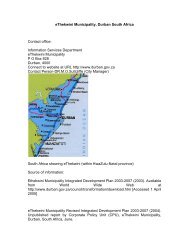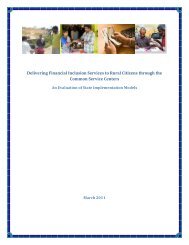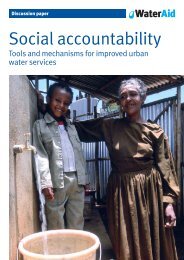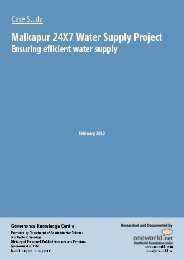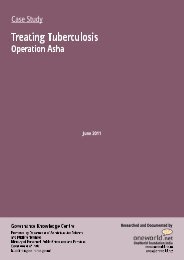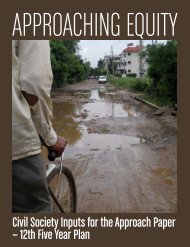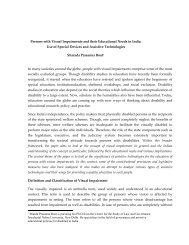EMRI model - Indiagovernance.gov.in
EMRI model - Indiagovernance.gov.in
EMRI model - Indiagovernance.gov.in
Create successful ePaper yourself
Turn your PDF publications into a flip-book with our unique Google optimized e-Paper software.
Study of Emergency Response Service (<strong>EMRI</strong> Scheme)lowers the number of cases per ambulance <strong>in</strong>itially and then it starts ris<strong>in</strong>g aga<strong>in</strong>. If theexpected absolute requirement <strong>in</strong> a population per one lakh is 22 cases per day, theneven at 70% effectiveness two ambulances are required. (8 cases per day perambulance). We could conclude by say<strong>in</strong>g that though reach<strong>in</strong>g <strong>in</strong> 20 m<strong>in</strong>utes <strong>in</strong> urban areas and 40m<strong>in</strong>utes <strong>in</strong> rural areas is the desirable norm, it is likely that <strong>in</strong> a large number of areas,for a considerable percentage of trips, this quality of response is as yet unatta<strong>in</strong>able. Ifwe were we to atta<strong>in</strong> universal ERS, we would probably require about two ambulancesper 1 lakh population each do<strong>in</strong>g 8 to 11 trips per day <strong>in</strong> an area with average populationdensity. With decreas<strong>in</strong>g population densities, progressively more ambulances per lakhpopulation and less number of trips per ambulance with a higher cost per trip would berequired. From this ball park figure we could project future utilisation trends and costs.Today Andhra is reach<strong>in</strong>g 8 trips per ambulance per day with one ambulance per 1.23lakh population at Rs 600 per ambulance trip or Rs 17.5 lakhs per ambulance per yearand for 652 ambulances the current year’s PIP bills Rs 114 crores. If this were to<strong>in</strong>crease to two ambulances per one lakh population, i.e 1600 ambulances for the stateand 11 trips per day per ambulance and also assume that average cost per trip were tostabilise at a lower Rs 475 per trip (estimate on optimum efficiency) then the costs wouldplateau at about Rs 304 crores - at current rates and without adjust<strong>in</strong>g for the <strong>in</strong>creasedcosts of low population density and high dispersion areas. Thus <strong>in</strong> Andhra Pradesh theexpenditure is currently about Rs 14 crores per crore of population per year and thiscould plateau at Rs 38 crores expenditure per crore of population per year for theprovision of universal ERS. This matches with <strong>EMRI</strong>’s <strong>in</strong>ternal estimates, which showsthat <strong>EMRI</strong> <strong>in</strong> Andhra Pradesh is handl<strong>in</strong>g only about one third of all emergencies today.And improved preventive public health action is probably not go<strong>in</strong>g to reduce <strong>in</strong>cidencesof emergencies for decl<strong>in</strong>e <strong>in</strong> pregnancies and communicable disease and road trafficaccidents would be offset by <strong>in</strong>creases <strong>in</strong> non communicable disease emergencies.What about <strong>in</strong>ter-hospital transfers? In all states, transfers between hospitals are notcovered by the MOU. Government owned and operated ambulances were play<strong>in</strong>g thisrole and therefore a parallel fleet of ambulances becomes necessary even where thereis <strong>EMRI</strong>. There are two views on this. The concern of the <strong>gov</strong>ernment has been that<strong>EMRI</strong> or whatever ERS is put <strong>in</strong> place must take care of <strong>in</strong>ter-hospital transfers too- thussav<strong>in</strong>g the <strong>gov</strong>ernment from a duplicat<strong>in</strong>g its expenses. <strong>EMRI</strong> on the other hand isconcerned that if it agrees to this, a considerable part of its resources would be shifted tothis task - which they estimate at 18% <strong>in</strong>crease over current requirements. This woulddisplace the priority of ERS. Shift<strong>in</strong>g a case from a block to a district hospital wouldmean a longer travel time and therefore for a longer time the ambulance would be busyand unavailable. An even greater concern is that many hospitals would, for a variety ofreasons, decide to pass many patients brought to it either by cherry pick<strong>in</strong>g “pay<strong>in</strong>g”cases with less complexity, or avoid<strong>in</strong>g the risks of manag<strong>in</strong>g more serious andNational Health Systems Resource Centre (NHSRC)23




